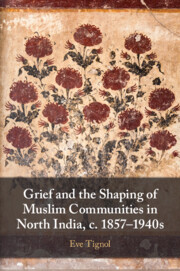Book contents
- Grief and the Shaping of Muslim Communities in north India, c. 1857–1940s
- Grief and the Shaping of Muslim Communities in north India, c. 1857–1940s
- Copyright page
- Contents
- Figures
- Acknowledgements
- Note on Transliteration
- Abbreviations
- Introduction
- 1 A Garden Lost
- 2 Useful Grief
- 3 Memorials, Feelings, and Public Recognition, c. 1911–1915
- 4 Empowering Grief
- 5 Nostalgia in Delhi
- Epilogue
- Glossary
- Bibliography
- Index
1 - A Garden Lost
Grief and Pain in 1857 shahr āshob Poetry
Published online by Cambridge University Press: 03 March 2023
- Grief and the Shaping of Muslim Communities in north India, c. 1857–1940s
- Grief and the Shaping of Muslim Communities in north India, c. 1857–1940s
- Copyright page
- Contents
- Figures
- Acknowledgements
- Note on Transliteration
- Abbreviations
- Introduction
- 1 A Garden Lost
- 2 Useful Grief
- 3 Memorials, Feelings, and Public Recognition, c. 1911–1915
- 4 Empowering Grief
- 5 Nostalgia in Delhi
- Epilogue
- Glossary
- Bibliography
- Index
Summary
This chapter provides an overview of the shahr āshob genre and analyses one collection of 1857 poems: The Lament for Delhi (Fuġhān-e Dehlī, 1863). Reassessing this body of texts through an analysis of its emotional language, it highlights its originality from previous Urdu shahr āshobs. The resort to elegiac literary devices and the association with the secular elegy (marṡiyah) paved the way for a particular expression of collective grief (ġham), in which it was associated with physical suffering and trauma. The contrast between pre-1857 paradise and post-1857 doomsday materialised in the image of the garden, which was deployed to describe the city as symbol of an ideal vision of Mughal political order.
Keywords
- Type
- Chapter
- Information
- Publisher: Cambridge University PressPrint publication year: 2023

